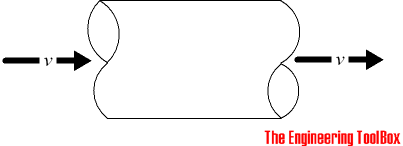Velocity Classification of Ventilation Ducts
Recommended air velocities in ventilation ducts
The duct velocity in air condition and ventilation systems should not exceed certain limits to avoid unnecessary noise generation and pressure drop in the duct work.

The limits of velocities depends on the actual application. The background noise in an industrial building is significant higher than the noise in a public building and more duct generated noise can be accepted.
Commonly accepted duct velocities are indicated in the table below.
| Service | Recommended Maximum Velocity - v - | |||
|---|---|---|---|---|
| Public buildings | Industrial plant | |||
| (m/s) | (ft/min) | (m/s) | (ft/min) | |
| Air intake from outside | 2.5 - 4.5 | 500 - 900 | 5 - 6 | 1000 - 1200 |
| Heater connection to fan | 3.5 - 4.5 | 700 - 900 | 5 - 7 | 1000 - 1400 |
| Main supply ducts | 5.0 - 8.0 | 1000 - 1500 | 6 - 12 | 1200 - 2400 |
| Branch supply ducts | 2.5 - 3.0 | 500 - 600 | 4.5 - 9 | 900 - 1800 |
| Supply registers and grilles | 1.2 - 2.3 | 250 - 450 | 1.5 - 2.5 | 350 - 500 |
| Low level supply registers | 0.8 - 1.2 | 150 - 250 | ||
| Main extract ducts | 4.5 - 8.0 | 900 - 1500 | 6 - 12 | 1200 - 2400 |
| Branch extract ducts | 2.5 - 3.0 | 500 - 600 | 4.5 - 9 | 900 - 1800 |
Ducts are commonly classified as
- Low Velocity Systems - with air velocities up to 2000 fpm (10 m/s)
- Medium Velocity Systems - with air velocities in the range 2000 to 2500 fpm (10 - 13 m/s)
- High Velocity Systems - with air velocities greater than 2500 fpm (> 13 m/s)



